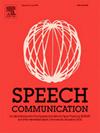Prosodic modulation of discourse markers: A cross-linguistic analysis of conversational dynamics
IF 2.4
3区 计算机科学
Q2 ACOUSTICS
引用次数: 0
Abstract
This paper delves into the fascinating world of prosody and pragmatics in discourse markers (DMs). We have come a long way since the early structural approaches, and now we are exploring dynamic models that reveal how prosody shapes DM interpretation in spoken discourse. Our journey takes us through various research methods, from acoustic analysis to naturalistic observations, each offering unique insights into how intonation, stress, and rhythm interact with DMs to guide conversations. Recent cross-linguistic studies, such as Ahn et al. (2024) on Korean “nay mali” and Wang et al. (2024) on Mandarin “haole,” demonstrate how prosodic detachment and contextual cues facilitate the evolution of DMs from lexical to pragmatic functions, underscoring the interplay between prosody and discourse management. Further cross-linguistic evidence comes from Vercher’s (2023) analysis of Spanish “entonces” and Siebold’s (2021) study on German “dann,” which highlight language-specific prosodic realizations of DMs in turn management and conversational closings. We are also looking at cross-linguistic patterns to uncover both universal trends and language-specific characteristics. It is amazing how cultural context plays such a crucial role in prosodic analysis. Besides, machine learning and AI are revolutionizing the field, allowing us to analyze prosodic features in massive datasets with unprecedented precision. We are now embracing multimodal analysis by combining prosody with non-verbal cues for a more holistic understanding of DMs in face-to-face communication. These findings have real-world applications, from improving speech recognition to enhancing language teaching methods. Looking ahead, we are advocating for an integrated approach that considers the dynamic interplay between prosody, pragmatics, and social context. There is still so much to explore across linguistic boundaries and diverse communicative settings. This review is not just a state-of-the-art overview. Rather, it is a roadmap for future research in this exciting field.
话语标记的韵律调节:会话动态的跨语言分析
本文探讨了语篇标记语的韵律和语用学的奇妙世界。自早期的结构方法以来,我们已经走了很长一段路,现在我们正在探索动态模型,揭示韵律如何影响口语话语中的DM解释。我们的旅程将带我们通过各种研究方法,从声学分析到自然观察,每种方法都提供了语调,重音和节奏如何与dm相互作用以指导对话的独特见解。最近的跨语言研究,如Ahn等人(2024)对韩语“nay mali”和Wang等人(2024)对普通话“haole”的研究,证明了韵律分离和上下文线索如何促进dm从词汇功能向语用功能的演变,强调了韵律和话语管理之间的相互作用。进一步的跨语言证据来自Vercher(2023)对西班牙语“entonces”的分析和Siebold(2021)对德语“dann”的研究,他们强调了dm在管理和会话结束方面的语言特定韵律实现。我们也在研究跨语言模式,以揭示通用趋势和特定语言特征。文化背景在韵律分析中起着如此重要的作用,这是令人惊讶的。此外,机器学习和人工智能正在彻底改变这一领域,使我们能够以前所未有的精度分析大量数据集中的韵律特征。我们现在正在采用多模态分析,将韵律和非语言线索结合起来,以更全面地了解面对面交流中的dm。这些发现具有实际应用价值,从提高语音识别到加强语言教学方法。展望未来,我们提倡采用一种综合的方法,考虑韵律、语用学和社会语境之间的动态相互作用。跨越语言界限和不同的交际环境,还有很多东西需要探索。这篇评论不仅仅是对最新技术的概述。相反,它是这个令人兴奋的领域未来研究的路线图。
本文章由计算机程序翻译,如有差异,请以英文原文为准。
求助全文
约1分钟内获得全文
求助全文
来源期刊

Speech Communication
工程技术-计算机:跨学科应用
CiteScore
6.80
自引率
6.20%
发文量
94
审稿时长
19.2 weeks
期刊介绍:
Speech Communication is an interdisciplinary journal whose primary objective is to fulfil the need for the rapid dissemination and thorough discussion of basic and applied research results.
The journal''s primary objectives are:
• to present a forum for the advancement of human and human-machine speech communication science;
• to stimulate cross-fertilization between different fields of this domain;
• to contribute towards the rapid and wide diffusion of scientifically sound contributions in this domain.
 求助内容:
求助内容: 应助结果提醒方式:
应助结果提醒方式:


